Minimizing the Main Strains and Thickness Reduction in the Single Point Incremental Forming Process of Polyamide and High-Density Polyethylene Sheets
Abstract
:1. Introduction
2. Materials and Methods
3. Results and Discussions
3.1. Main Strains and Thickness Reduction Determination during Incremental Forming of PA and HDPE Sheets for Frustum of Cone-Shaped Parts
3.2. Analysis of the Signal-to-Noise Ratio for the Main Strains and Thickness Reduction during the Incremental Forming of PA and HDPE Sheets
3.3. Analysis of Variance (ANOVA) for the Main Strains and Thickness Reduction during the Incremental Forming of PA and HDPE Sheets
3.4. Regression Analysis for the Thickness Reduction during the Incremental Forming of PA and HDPE Sheets
3.5. Determination of the Main Strains and Thickness Reduction during Incremental Forming of PA and HDPE Sheets for Frustum of Pyramid-Shaped Parts
4. Conclusions
Supplementary Materials
Author Contributions
Funding
Institutional Review Board Statement
Informed Consent Statement
Data Availability Statement
Acknowledgments
Conflicts of Interest
Appendix A
| Code | Mat. | α (°) | Dp (mm) | s (mm) | εx1 (mm/mm) | εx2 (mm/mm) | εx Mean (mm/mm) | Standard Deviation | S/N Ratio | Coefficient of Variation |
|---|---|---|---|---|---|---|---|---|---|---|
| S1 | PA | 50 | 6 | 0.5000 | 0.5423 | 0.5445 | 0.5434 | 0.0015 | 5.2978 | 0.0028 |
| S2 | PA | 50 | 8 | 0.7500 | 0.5170 | 0.5144 | 0.5157 | 0.0018 | 5.7519 | 0.0035 |
| S3 | PA | 50 | 10 | 1.0000 | 0.4655 | 0.4581 | 0.4618 | 0.0053 | 6.7111 | 0.0114 |
| S4 | PA | 55 | 6 | 0.7500 | 0.6874 | 0.6779 | 0.6826 | 0.0067 | 3.3159 | 0.0098 |
| S5 | PA | 55 | 8 | 1.0000 | 0.6542 | 0.6346 | 0.6444 | 0.0139 | 3.8161 | 0.0215 |
| S6 | PA | 55 | 10 | 0.5000 | 0.6330 | 0.6374 | 0.6352 | 0.0031 | 3.9415 | 0.0049 |
| S7 | PA | 60 | 6 | 1.0000 | 0.8470 | 0.8318 | 0.8394 | 0.0108 | 1.5205 | 0.0128 |
| S8 | PA | 60 | 8 | 0.5000 | 0.7560 | 0.7605 | 0.7583 | 0.0032 | 2.4035 | 0.0042 |
| S9 | PA | 60 | 10 | 0.7500 | 0.7490 | 0.7545 | 0.7517 | 0.0039 | 2.4786 | 0.0052 |
| S10 | HDPE | 50 | 6 | 0.5000 | 0.4736 | 0.4618 | 0.4677 | 0.0084 | 6.6003 | 0.0179 |
| S11 | HDPE | 50 | 8 | 0.7500 | 0.4220 | 0.4161 | 0.4190 | 0.0042 | 7.5546 | 0.0100 |
| S12 | HDPE | 50 | 10 | 1.0000 | 0.4220 | 0.4110 | 0.4165 | 0.0078 | 7.6067 | 0.0186 |
| S13 | HDPE | 55 | 6 | 0.7500 | 0.5710 | 0.5765 | 0.5737 | 0.0039 | 4.8256 | 0.0067 |
| S14 | HDPE | 55 | 8 | 1.0000 | 0.5563 | 0.5396 | 0.5480 | 0.0118 | 5.2241 | 0.0215 |
| S15 | HDPE | 55 | 10 | 0.5000 | 0.5076 | 0.5005 | 0.5040 | 0.0050 | 5.9504 | 0.0100 |
| S16 | HDPE | 60 | 6 | 1.0000 | 0.6790 | 0.6546 | 0.6668 | 0.0173 | 3.5189 | 0.0259 |
| S17 | HDPE | 60 | 8 | 0.5000 | 0.6702 | 0.7037 | 0.6870 | 0.0237 | 3.2589 | 0.0345 |
| S18 | HDPE | 60 | 10 | 0.7500 | 0.5770 | 0.5621 | 0.5696 | 0.0105 | 4.8885 | 0.0185 |
| Code | Mat. | α (°) | Dp (mm) | s (mm) | εy1 (mm/mm) | εy2 (mm/mm) | εy Mean (mm/mm) | Standard Deviation | S/N Ratio | Coefficient of variation |
|---|---|---|---|---|---|---|---|---|---|---|
| S1 | PA | 50 | 6 | 0.5000 | 0.5484 | 0.5418 | 0.5451 | 0.0047 | 5.2702 | 0.0085 |
| S2 | PA | 50 | 8 | 0.7500 | 0.5104 | 0.5196 | 0.5150 | 0.0065 | 5.7636 | 0.0126 |
| S3 | PA | 50 | 10 | 1.0000 | 0.4560 | 0.4674 | 0.4617 | 0.0081 | 6.7121 | 0.0175 |
| S4 | PA | 55 | 6 | 0.7500 | 0.6749 | 0.7011 | 0.6880 | 0.0185 | 3.2468 | 0.0269 |
| S5 | PA | 55 | 8 | 1.0000 | 0.6306 | 0.6621 | 0.6464 | 0.0223 | 3.7879 | 0.0345 |
| S6 | PA | 55 | 10 | 0.5000 | 0.6328 | 0.6410 | 0.6369 | 0.0058 | 3.9182 | 0.0091 |
| S7 | PA | 60 | 6 | 1.0000 | 0.8390 | 0.8457 | 0.8424 | 0.0047 | 1.4900 | 0.0056 |
| S8 | PA | 60 | 8 | 0.5000 | 0.7650 | 0.7466 | 0.7558 | 0.0130 | 2.4310 | 0.0172 |
| S9 | PA | 60 | 10 | 0.7500 | 0.7580 | 0.7453 | 0.7516 | 0.0090 | 2.4796 | 0.0120 |
| S10 | HDPE | 50 | 6 | 0.5000 | 0.4645 | 0.4733 | 0.4689 | 0.0062 | 6.5778 | 0.0133 |
| S11 | HDPE | 50 | 8 | 0.7500 | 0.4160 | 0.4170 | 0.4165 | 0.0007 | 7.6077 | 0.0017 |
| S12 | HDPE | 50 | 10 | 1.0000 | 0.4100 | 0.4272 | 0.4186 | 0.0122 | 7.5620 | 0.0291 |
| S13 | HDPE | 55 | 6 | 0.7500 | 0.5720 | 0.5753 | 0.5737 | 0.0023 | 4.8269 | 0.0041 |
| S14 | HDPE | 55 | 8 | 1.0000 | 0.5214 | 0.5459 | 0.5337 | 0.0173 | 5.4525 | 0.0325 |
| S15 | HDPE | 55 | 10 | 0.5000 | 0.4921 | 0.5001 | 0.4961 | 0.0056 | 6.0886 | 0.0114 |
| S16 | HDPE | 60 | 6 | 1.0000 | 0.6486 | 0.6778 | 0.6632 | 0.0206 | 3.5651 | 0.0311 |
| S17 | HDPE | 60 | 8 | 0.5000 | 0.7230 | 0.6876 | 0.7053 | 0.0251 | 3.0300 | 0.0355 |
| S18 | HDPE | 60 | 10 | 0.7500 | 0.5616 | 0.5811 | 0.5714 | 0.0138 | 4.8603 | 0.0242 |
| Code | Mat. | α (°) | Dp (mm) | s (mm) | ε11 (mm/mm) | ε12 (mm/mm) | ε1 Mean (mm/mm) | Standard Deviation | S/N Ratio | Coefficient of Variation |
|---|---|---|---|---|---|---|---|---|---|---|
| S1 | PA | 50 | 6 | 0.5000 | 0.5510 | 0.5497 | 0.5503 | 0.0009 | 5.1874 | 0.0017 |
| S2 | PA | 50 | 8 | 0.7500 | 0.5210 | 0.5220 | 0.5215 | 0.0007 | 5.6546 | 0.0014 |
| S3 | PA | 50 | 10 | 1.0000 | 0.4680 | 0.4624 | 0.4652 | 0.0040 | 6.6472 | 0.0085 |
| S4 | PA | 55 | 6 | 0.7500 | 0.7008 | 0.6946 | 0.6977 | 0.0044 | 3.1263 | 0.0063 |
| S5 | PA | 55 | 8 | 1.0000 | 0.6605 | 0.6519 | 0.6562 | 0.0061 | 3.6590 | 0.0093 |
| S6 | PA | 55 | 10 | 0.5000 | 0.6482 | 0.6498 | 0.6490 | 0.0011 | 3.7554 | 0.0017 |
| S7 | PA | 60 | 6 | 1.0000 | 0.8520 | 0.8481 | 0.8500 | 0.0028 | 1.4112 | 0.0033 |
| S8 | PA | 60 | 8 | 0.5000 | 0.7870 | 0.7930 | 0.7900 | 0.0042 | 2.0475 | 0.0054 |
| S9 | PA | 60 | 10 | 0.7500 | 0.7594 | 0.7678 | 0.7636 | 0.0060 | 2.3423 | 0.0078 |
| S10 | HDPE | 50 | 6 | 0.5000 | 0.5070 | 0.5037 | 0.5053 | 0.0024 | 5.9285 | 0.0047 |
| S11 | HDPE | 50 | 8 | 0.7500 | 0.4280 | 0.4681 | 0.4480 | 0.0283 | 6.9649 | 0.0633 |
| S12 | HDPE | 50 | 10 | 1.0000 | 0.4300 | 0.4257 | 0.4278 | 0.0031 | 7.3745 | 0.0072 |
| S13 | HDPE | 55 | 6 | 0.7500 | 0.6064 | 0.6018 | 0.6041 | 0.0032 | 4.3776 | 0.0054 |
| S14 | HDPE | 55 | 8 | 1.0000 | 0.5990 | 0.6007 | 0.5998 | 0.0012 | 4.4393 | 0.0020 |
| S15 | HDPE | 55 | 10 | 0.5000 | 0.5117 | 0.5014 | 0.5065 | 0.0073 | 5.9074 | 0.0144 |
| S16 | HDPE | 60 | 6 | 1.0000 | 0.6874 | 0.6911 | 0.6892 | 0.0026 | 3.2327 | 0.0037 |
| S17 | HDPE | 60 | 8 | 0.5000 | 0.6851 | 0.6939 | 0.6895 | 0.0062 | 3.2291 | 0.0090 |
| S18 | HDPE | 60 | 10 | 0.7500 | 0.5812 | 0.5786 | 0.5799 | 0.0018 | 4.7326 | 0.0031 |
| Code | Mat. | α (°) | Dp (mm) | s (mm) | ε21 (mm/mm) | ε22 (mm/mm) | ε2 Mean (mm/mm) | Standard Deviation | S/N Ratio | Coefficient of Variation |
|---|---|---|---|---|---|---|---|---|---|---|
| S1 | PA | 50 | 6 | 0.5000 | 0.1530 | 0.1582 | 0.1556 | 0.0037 | 16.1586 | 0.0236 |
| S2 | PA | 50 | 8 | 0.7500 | 0.1320 | 0.1498 | 0.1409 | 0.0126 | 17.0045 | 0.0893 |
| S3 | PA | 50 | 10 | 1.0000 | 0.2320 | 0.1876 | 0.2098 | 0.0314 | 13.5155 | 0.1496 |
| S4 | PA | 55 | 6 | 0.7500 | 0.0700 | 0.0810 | 0.0755 | 0.0078 | 22.4181 | 0.1030 |
| S5 | PA | 55 | 8 | 1.0000 | 0.0844 | 0.1090 | 0.0967 | 0.0174 | 20.2218 | 0.1799 |
| S6 | PA | 55 | 10 | 0.5000 | 0.1270 | 0.1160 | 0.1215 | 0.0078 | 18.2996 | 0.0640 |
| S7 | PA | 60 | 6 | 1.0000 | 0.0789 | 0.0753 | 0.0771 | 0.0025 | 22.2565 | 0.0330 |
| S8 | PA | 60 | 8 | 0.5000 | 0.1230 | 0.1080 | 0.1155 | 0.0106 | 18.7301 | 0.0918 |
| S9 | PA | 60 | 10 | 0.7500 | 0.0966 | 0.0744 | 0.0855 | 0.0157 | 21.2881 | 0.1836 |
| S10 | HDPE | 50 | 6 | 0.5000 | 0.1979 | 0.1654 | 0.1817 | 0.0230 | 14.7807 | 0.1265 |
| S11 | HDPE | 50 | 8 | 0.7500 | 0.1820 | 0.1730 | 0.1775 | 0.0064 | 15.0132 | 0.0359 |
| S12 | HDPE | 50 | 10 | 1.0000 | 0.2530 | 0.2142 | 0.2336 | 0.0274 | 12.6007 | 0.1174 |
| S13 | HDPE | 55 | 6 | 0.7500 | 0.1085 | 0.0970 | 0.1028 | 0.0081 | 19.7508 | 0.0791 |
| S14 | HDPE | 55 | 8 | 1.0000 | 0.1771 | 0.1463 | 0.1617 | 0.0218 | 15.7866 | 0.1347 |
| S15 | HDPE | 55 | 10 | 0.5000 | 0.1270 | 0.1452 | 0.1361 | 0.0129 | 17.3035 | 0.0946 |
| S16 | HDPE | 60 | 6 | 1.0000 | 0.0915 | 0.0888 | 0.0902 | 0.0019 | 20.8997 | 0.0212 |
| S17 | HDPE | 60 | 8 | 0.5000 | 0.1560 | 0.1387 | 0.1474 | 0.0122 | 16.6181 | 0.0830 |
| S18 | HDPE | 60 | 10 | 0.7500 | 0.1038 | 0.0987 | 0.1013 | 0.0036 | 19.8893 | 0.0356 |
| Code | Mat. | α (°) | Dp (mm) | s (mm) | γxy,1 (°) | γxy,2 (°) | γxy Mean (°) | Standard Deviation | S/N Ratio | Coefficient of Variation |
|---|---|---|---|---|---|---|---|---|---|---|
| S1 | PA | 50 | 6 | 0.5000 | 25.9000 | 25.4000 | 25.6500 | 0.3536 | −28.1822 | 0.0138 |
| S2 | PA | 50 | 8 | 0.7500 | 25.1000 | 23.8000 | 24.4500 | 0.9192 | −27.7686 | 0.0376 |
| S3 | PA | 50 | 10 | 1.0000 | 21.9000 | 22.3000 | 22.1000 | 0.2828 | −26.8882 | 0.0128 |
| S4 | PA | 55 | 6 | 0.7500 | 34.8000 | 33.1400 | 33.9700 | 1.1738 | −30.6245 | 0.0346 |
| S5 | PA | 55 | 8 | 1.0000 | 32.0100 | 31.8500 | 31.9300 | 0.1131 | −30.0840 | 0.0035 |
| S6 | PA | 55 | 10 | 0.5000 | 30.8500 | 30.1000 | 30.4750 | 0.5303 | −29.6795 | 0.0174 |
| S7 | PA | 60 | 6 | 1.0000 | 41.8000 | 38.2000 | 40.0000 | 2.5456 | −32.0500 | 0.0636 |
| S8 | PA | 60 | 8 | 0.5000 | 36.1700 | 37.4000 | 36.7850 | 0.8697 | −31.3146 | 0.0236 |
| S9 | PA | 60 | 10 | 0.7500 | 35.7800 | 35.0200 | 35.4000 | 0.5374 | −30.9806 | 0.0152 |
| S10 | HDPE | 50 | 6 | 0.5000 | 18.8000 | 19.4000 | 19.1000 | 0.4243 | −25.6217 | 0.0222 |
| S11 | HDPE | 50 | 8 | 0.7500 | 17.2000 | 17.8000 | 17.5000 | 0.4243 | −24.8620 | 0.0242 |
| S12 | HDPE | 50 | 10 | 1.0000 | 16.8000 | 14.8000 | 15.8000 | 1.4142 | −23.9905 | 0.0895 |
| S13 | HDPE | 55 | 6 | 0.7500 | 26.9600 | 27.5000 | 27.2300 | 0.3818 | −28.7014 | 0.0140 |
| S14 | HDPE | 55 | 8 | 1.0000 | 25.0000 | 24.6800 | 24.8400 | 0.2263 | −27.9032 | 0.0091 |
| S15 | HDPE | 55 | 10 | 0.5000 | 22.6000 | 21.9000 | 22.2500 | 0.4950 | −26.9477 | 0.0222 |
| S16 | HDPE | 60 | 6 | 1.0000 | 31.9100 | 31.9400 | 31.9250 | 0.0212 | −30.0826 | 0.0007 |
| S17 | HDPE | 60 | 8 | 0.5000 | 29.9500 | 30.3000 | 30.1250 | 0.2475 | −29.5787 | 0.0082 |
| S18 | HDPE | 60 | 10 | 0.7500 | 27.9400 | 27.3700 | 27.6550 | 0.4031 | −28.8359 | 0.0146 |
References
- Ben Said, L. The incremental sheet forming; technology, modeling and formability: A brief review. Proc. Inst. Mech. Eng. Part E J. Process Mech. Eng. 2022, 236, 2729–2755. [Google Scholar] [CrossRef]
- Magdum, R.A.; Chinnaiyan, P. A critical review of incremental sheet forming in view of process parameters and process output. Adv. Mater. Process. Technol. 2022, 8, 2039–2068. [Google Scholar] [CrossRef]
- Liu, F.; Li, Y.; Ghafoor, S.; Cheng, Z.; Li, F.; Li, J. Sustainability assessment of incremental sheet forming: A review. Int. J. Adv. Manuf. Technol. 2022, 119, 1385–1405. [Google Scholar] [CrossRef]
- Esmailian, M.; Khalili, K. Two-Point Incremental Forming of Metal-Polymer Three-Layer Sheets. Iran. J. Sci. Technol. Trans. Mech. Eng. 2021, 45, 181–196. [Google Scholar] [CrossRef]
- Miroir, M.; Laniel, R.; Brient, A.; Kerbrat, O. Water jet incremental sheet metal forming: A critical state-of-the-art review and a proposal for technological windows. Int. J. Adv. Manuf. Technol. 2022, 119, 4159–4175. [Google Scholar] [CrossRef]
- Hassan, M.; Hussain, G.; Wei, H.; Qadeer, A.; AlKahtani, M. Progress on single-point incremental forming of polymers. Int. J. Adv. Manuf. Technol. 2021, 114, 1–26. [Google Scholar] [CrossRef]
- Amala Justus Selvam, M.; Velu, R.; Dheerankumar, T. Study of the influence of the process variables on formability and strain distribution in incremental sheet metal working of AA 1050 sheets. In Lecture Notes in Mechanical Engineering; Springer: Singapore, 2017; pp. 493–505. [Google Scholar]
- Kumar, G.; Maji, K. Investigations on formability of tailor laminated sheets in single point incremental forming. Proc. Inst. Mech. Eng. Part B J. Eng. Manuf. 2022, 236, 1393–1405. [Google Scholar] [CrossRef]
- Raju, C.; Haloi, N.; Sathiya Narayanan, C. Strain distribution and failure mode in single point incremental forming (SPIF) of multiple commercially pure aluminum sheets. J. Manuf. Process. 2017, 30, 328–335. [Google Scholar] [CrossRef]
- Mugendiran, V.; Gnanavelbabu, A. Comparison of plastic strains on AA5052 by single point incremental forming process using digital image processing. J. Mech. Sci. Technol. 2017, 31, 2943–2949. [Google Scholar] [CrossRef]
- Vanhulst, M.; Vanhove, H.; Carette, Y.; Waumans, S.; Duflou, J.R. Analysis of Thickness Distributions Calculated from Surface Strains Obtained through Digital Image Correlation for Incremental Sheet Forming. In Key Engineering Materials; Trans Tech Publications Ltd.: Bäch, Switzerland, 2022; Volume 926, pp. 875–882. [Google Scholar]
- Marques, T.A.; Silva, M.B.; Martins, P.A.F. On the potential of single point incremental forming of sheet polymer parts. Int. J. Adv. Manuf. Technol. 2012, 60, 75–86. [Google Scholar] [CrossRef]
- Zhu, H.; Ou, H.; Popov, A. Incremental sheet forming of thermoplastics: A review. Int. J. Adv. Manuf. Technol. 2020, 111, 565–587. [Google Scholar] [CrossRef]
- Rosca, N.; Trzepieciński, T.; Oleksik, V. Minimizing the Forces in the Single Point Incremental Forming Process of Polymeric Materials Using Taguchi Design of Experiments and Analysis of Variance. Materials 2022, 15, 6453. [Google Scholar] [CrossRef] [PubMed]
- Franzen, V.; Kwiatkowski, L.; Martins, P.A.F.; Tekkaya, A.E. Single point incremental forming of PVC. J. Mater. Process. Technol. 2009, 209, 462–469. [Google Scholar] [CrossRef]
- Beşliu, I.; Tamaşag, I.; Slătineanu, L. An Experimental Study on Incremental Forming Process of Polycarbonate Sheets. Macromol. Symp. 2021, 395, 2000282. [Google Scholar] [CrossRef]
- Emami, R.; Mirnia, M.J.; Elyasi, M.; Zolfaghari, A. An experimental investigation into single point incremental forming of glass fiber-reinforced polyamide sheet with different fiber orientations and volume fractions at elevated temperatures. J. Thermoplast. Compos. Mater. 2022; in press, first published online. [Google Scholar] [CrossRef]
- Bagheri, S.; Kami, A.; Shakouri, M. Single point incremental forming of polyamide/30 wt% short glass fiber composite. J. Thermoplast. Compos. Mater. 2022; in press, first published online. [Google Scholar] [CrossRef]
- Borić, A.; Kalendová, A.; Urbanek, M.; Pepelnjak, T. Characterisation of polyamide (PA)12 nanocomposites withmontmorillonite (MMT) filler clay used for the incremental forming of sheets. Polymers 2019, 11, 1284. [Google Scholar] [CrossRef] [PubMed]
- Davarpanah, M.A.; Bansal, S.; Malhotra, R. Influence of Single Point Incremental Forming on Mechanical Properties and Chain Orientation in Thermoplastic Polymers. J. Manuf. Sci. Eng. Trans. ASME 2017, 139, 021012. [Google Scholar] [CrossRef]
- Rajenthirakumar, D.; Sridhar, R. Single point incremental sheet forming of polymer on Computer Numerically Controlled (CNC) milling machine tool. Key Eng. Mater. 2014, 622–623, 420–426. [Google Scholar] [CrossRef]
- Ostasevicius, V.; Eidukynas, D.; Grigaliunas, V.; Jurenas, V.; Paleviciute, I.; Gudauskis, M. Investigation of advanced robotized polymer sheet incremental forming process. Sensors 2021, 21, 7459. [Google Scholar] [CrossRef]
- Durante, M.; Formisano, A.; Lambiase, F. Formability of polycarbonate sheets in single-point incremental forming. Int. J. Adv. Manuf. Technol. 2019, 102, 2049–2062. [Google Scholar] [CrossRef]
- Rosa-Sainz, A.; Centeno, G.; Silva, M.B.; Vallellano, C. Experimental failure analysis in polycarbonate sheet deformed by SPIF. J. Manuf. Process. 2021, 64, 1153–1168. [Google Scholar] [CrossRef]
- Bagudanch, I.; Centeno, G.; Vallellano, C.; Garcia-Romeu, M.L. Revisiting formability and failure of polymeric sheets deformed by Single Point Incremental Forming. Polym. Degrad. Stab. 2017, 144, 366–377. [Google Scholar] [CrossRef]
- Formisano, A.; Durante, M. A numerical-experimental investigation of the wrinkling defect in incremental forming of thin polycarbonate sheets. Int. Rev. Model. Simul. 2019, 12, 206–211. [Google Scholar] [CrossRef]
- Kulkarni, S.S.; Mocko, G.M. A finite element simulation model of convective heat-assisted single-point incremental forming of thermoplastics. Int. J. Adv. Manuf. Technol. 2020, 111, 3305–3317. [Google Scholar] [CrossRef]
- Barimani-Varandi, A.; Nasrabadi, M.K.; Ravan, B.A.; Javadi, M. Rapid prototyping of aircraft canopy based on the incremental forming process. J. Braz. Soc. Mech. Sci. Eng. 2021, 43, 59. [Google Scholar] [CrossRef]
- Cristino, V.A.M.; Silva, M.B.; Wong, P.K.; Tam, L.M.; Martins, P.A.F. Hole-flanging of metals and polymers produced by single point incremental forming. Int. J. Mater. Prod. Technol. 2015, 50, 37–48. [Google Scholar] [CrossRef]
- Centeno, G.; Morales-Palma, D.; Gonzalez-Perez-Somarriba, B.; Bagudanch, I.; Egea-Guerrero, J.J.; Gonzalez-Perez, L.M.; García-Romeu, M.L.; Vallellano, C. A functional methodology on the manufacturing of customized polymeric cranial prostheses from CAT using SPIF. Rapid Prototyp. J. 2017, 23, 771–780. [Google Scholar] [CrossRef]
- Ortiz-Hernández, R.; Ulloa-Castillo, N.A.; Diabb-Zavala, J.M.; Vega, A.E.D.L.; Islas-Urbano, J.; Villela-Castrejón, J.; Elías-Zúñiga, A. Advances in the processing of UHMWPE-TiO2 to manufacture medical prostheses via SPIF. Polymers 2019, 11, 2022. [Google Scholar] [CrossRef] [Green Version]
- Lozano-Sánchez, L.M.; Bagudanch, I.; Sustaita, A.O.; Iturbe-Ek, J.; Elizalde, L.E.; Garcia-Romeu, M.L.; Elías-Zúñiga, A. Single-point incremental forming of two biocompatible polymers: An insight into their thermal and structural properties. Polymers 2018, 10, 391. [Google Scholar] [CrossRef] [Green Version]
- Al-Ghamdi, K.A. Spring back analysis in incremental forming of polypropylene sheet: An experimental study. J. Mech. Sci. Technol. 2018, 32, 4859–4869. [Google Scholar] [CrossRef]
- Feng, X.Y.; Zha, G.C.; Jiang, Z.D.; Yan, F.Y.; Mo, S.Y. Research on wrinkle defects of PE sheet based on incremental forming. J. Plast. Eng. 2021, 28, 61–68. [Google Scholar] [CrossRef]
- Maaß, F.; Gies, S.; Tekkaya, A.E. Deformation characteristics of thermoplastics in single point incremental forming. AIP Conf. Proc. 2017, 1896, 050005. [Google Scholar]
- Jain, P.S.; Kagzi, S.A.; Patel, S.; Vasava, J. An analysis of the effect of various parameters on surface roughness, springback and thinning while performing single point incremental forming on polypropylene sheet. Proc. Inst. Mech. Eng. Part E J. Process Mech. Eng. 2021; in press. [Google Scholar] [CrossRef]
- Patel, S.; Kagzi, S.; Jain, P. Investigation of Different Factors Influencing the Springback, Surface Roughness, and Thinning for Polyvinyl Chloride during Single Point Incremental Forming. SAE Int. J. Mater. Manuf. 2020, 13, 297–306. [Google Scholar] [CrossRef]
- Kharche, A.; Barve, S. Experimental investigations of machining parameters on polyamide 6 using single point incremental forming. Mater. Today Proc. 2022; in press, first published online. [Google Scholar] [CrossRef]
- Sabater, M.; Garcia-Romeu, M.L.; Vives-Mestres, M.; Ferrer, I.; Bagudanch, I. Process parameter effects on biocompatible thermoplastic sheets produced by incremental forming. Materials 2018, 11, 1377. [Google Scholar] [CrossRef] [Green Version]
- Thangavel, K.; Duraiswamy, R.; Nagarajan, S.; Ramasamy, S. Influence of roller ball tool in single point incremental forming of polymers. Teh. Vjesn. 2019, 26, 171–176. [Google Scholar] [CrossRef]
- Medina-Sanchez, G.; Garcia-Collado, A.; Carou, D.; Dorado-Vicente, R. Force prediction for incremental forming of polymer sheets. Materials 2018, 11, 1597. [Google Scholar] [CrossRef] [Green Version]
- Rai, S.; Kumar, R.; Nirala, H.K.; Francis, K.; Agrawal, A. Experimental and simulation study of single point incremental forming of polycarbonate. In Proceedings of the ASME 2019 14th International Manufacturing Science and Engineering Conference MSEC, Erie, PA, USA, 10–14 June 2019. [Google Scholar] [CrossRef]
- Wei, H.; Hussain, G.; Heidarshenas, B.; Alkahtani, M. Post-forming mechanical properties of a polymer sheet processed by incremental sheet forming: Insights into effects of plastic strain, and orientation and size of specimen. Polymers 2020, 12, 1870. [Google Scholar] [CrossRef] [PubMed]
- Harhash, M.; Palkowski, H. Incremental sheet forming of steel/polymer/steel sandwich composites. J. Mater. Res. Technol. 2021, 13, 417–430. [Google Scholar] [CrossRef]
- GOM mbH. Aramis v6. User Manual—Software; GOM mbH: Braunschweig, Germany, 2007. [Google Scholar]
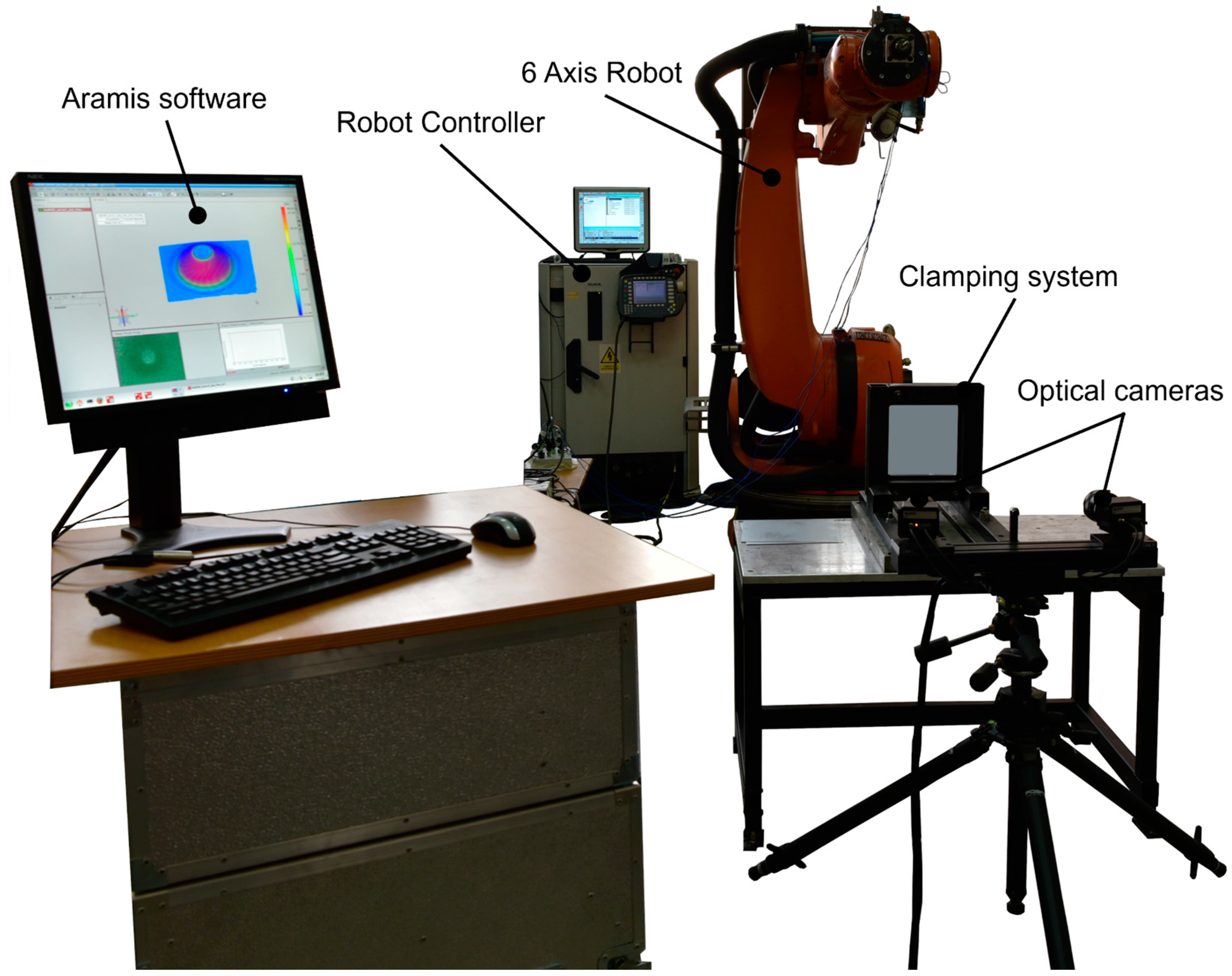
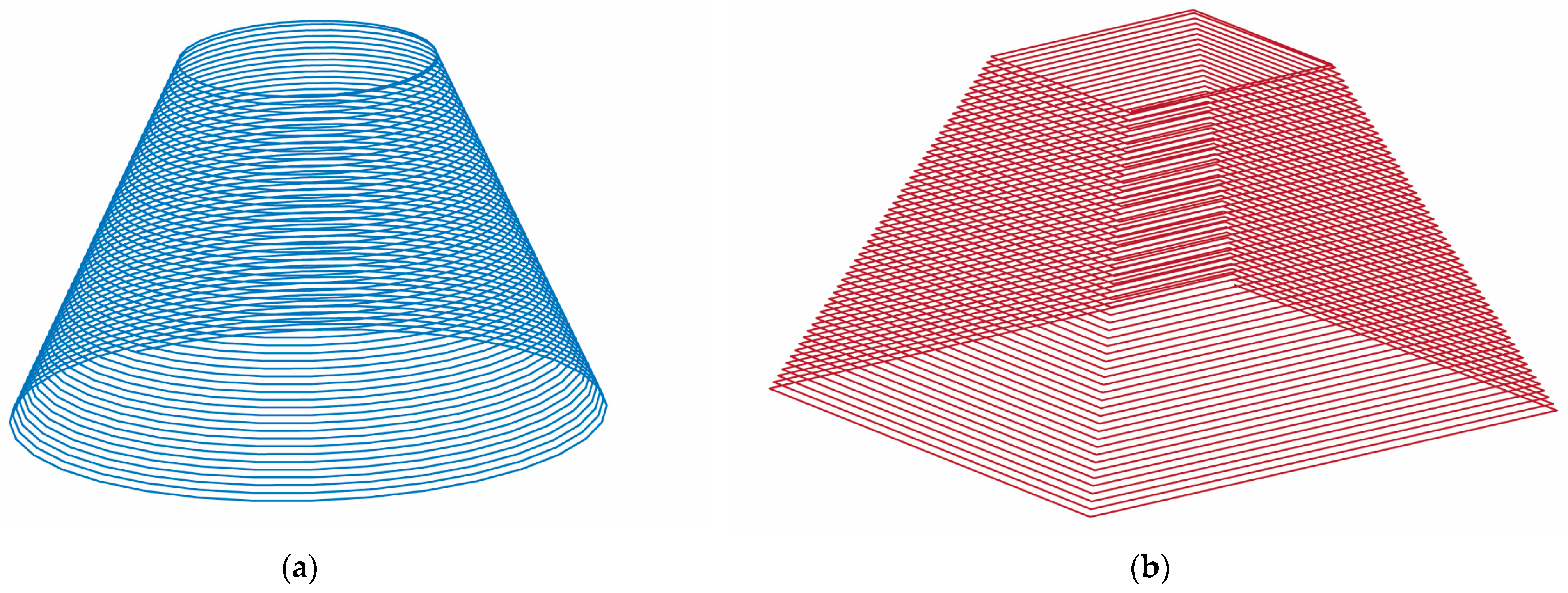
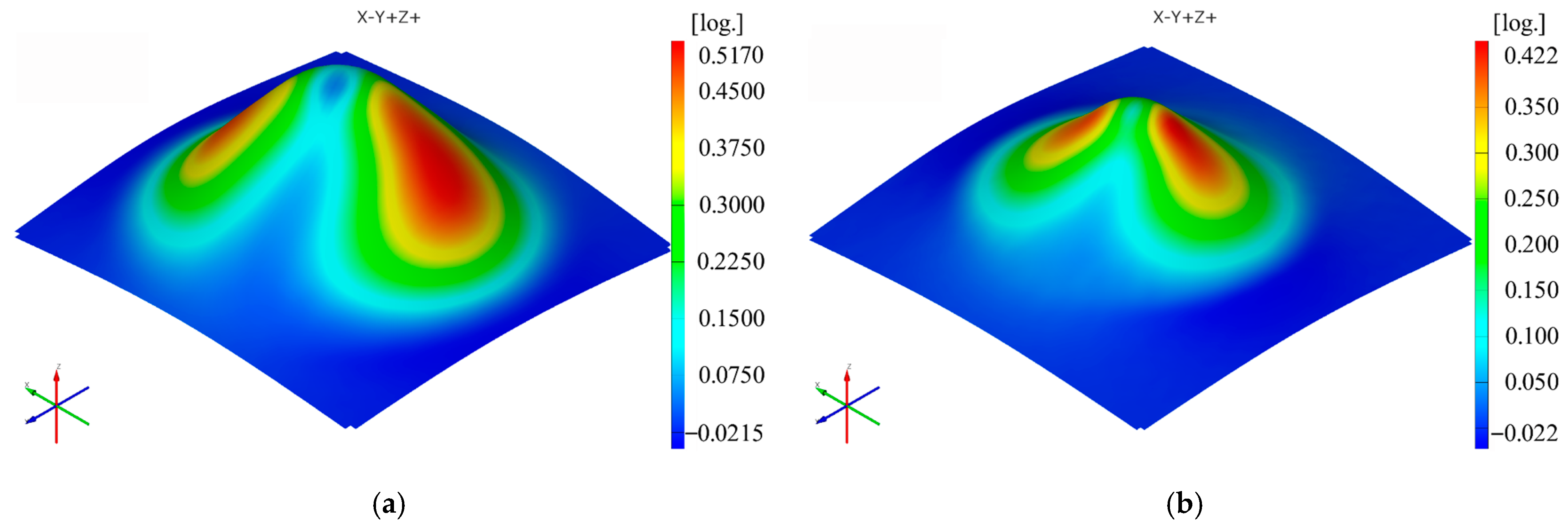
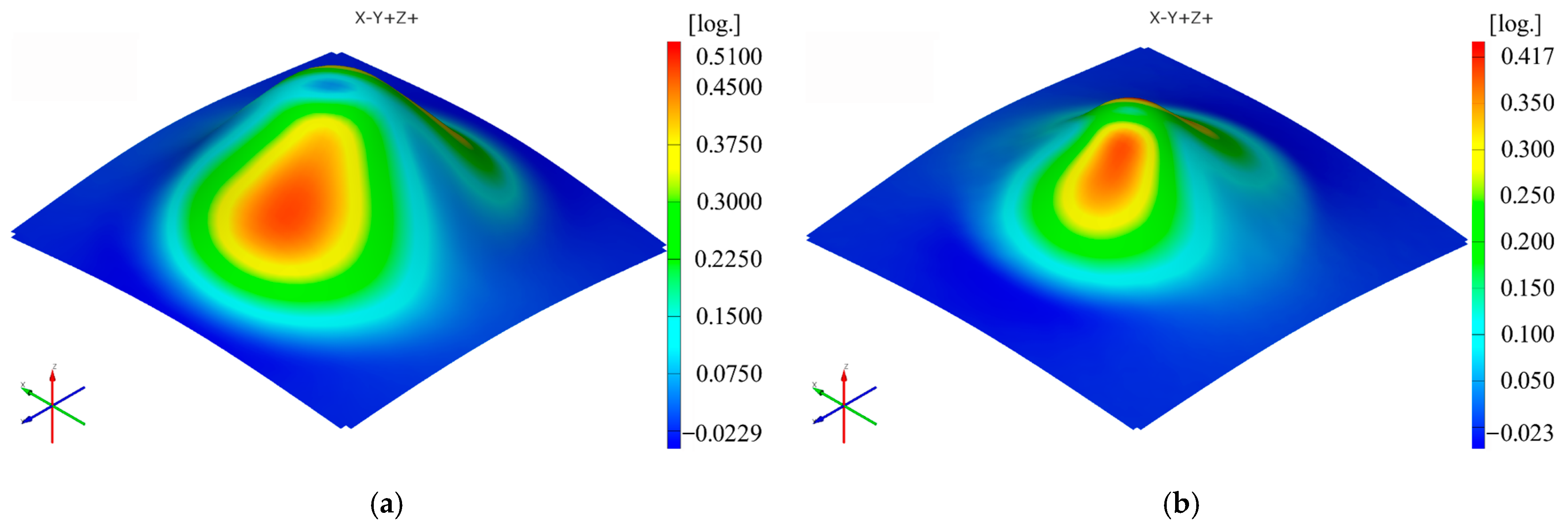
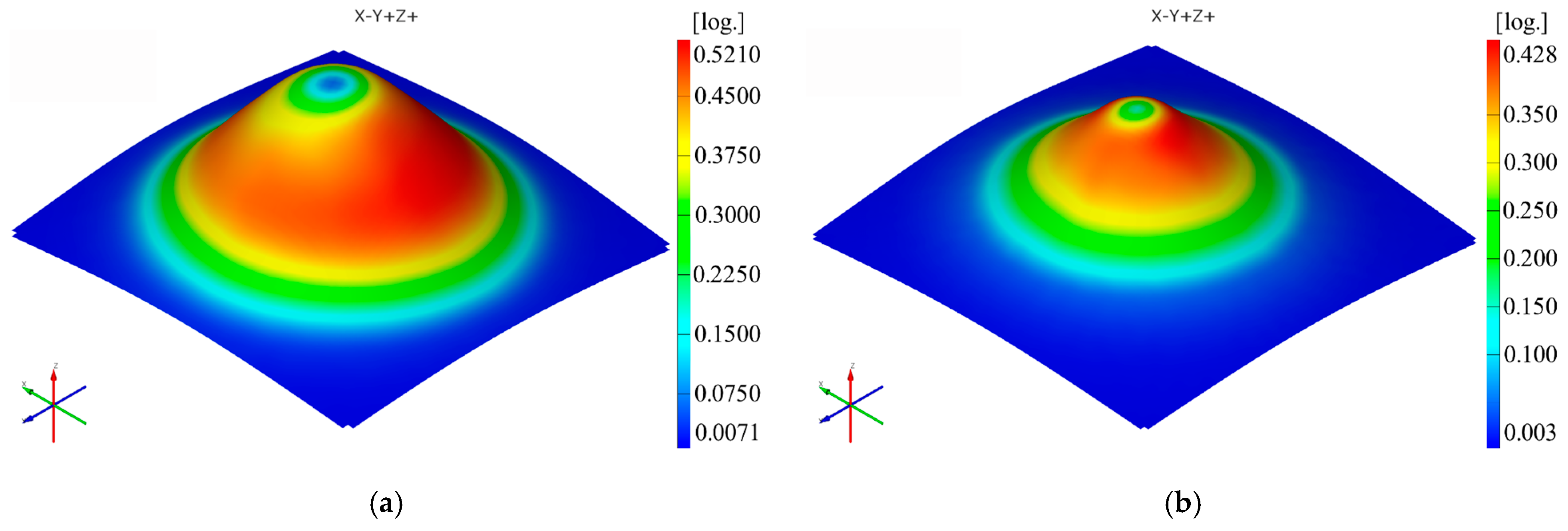
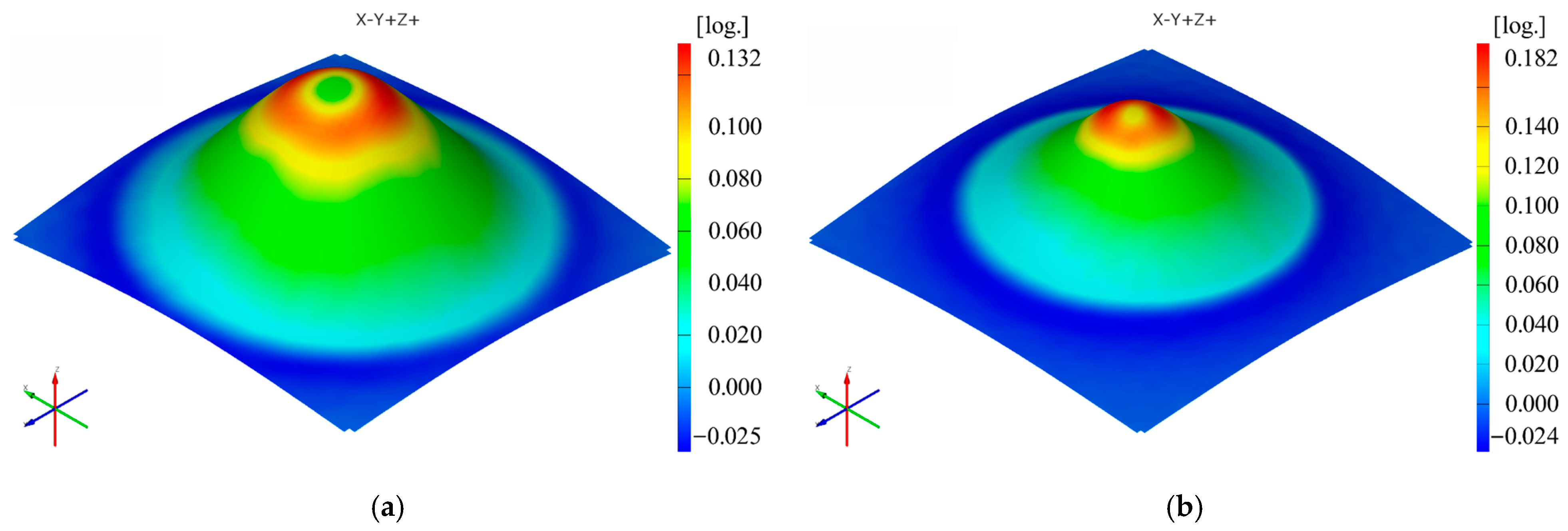
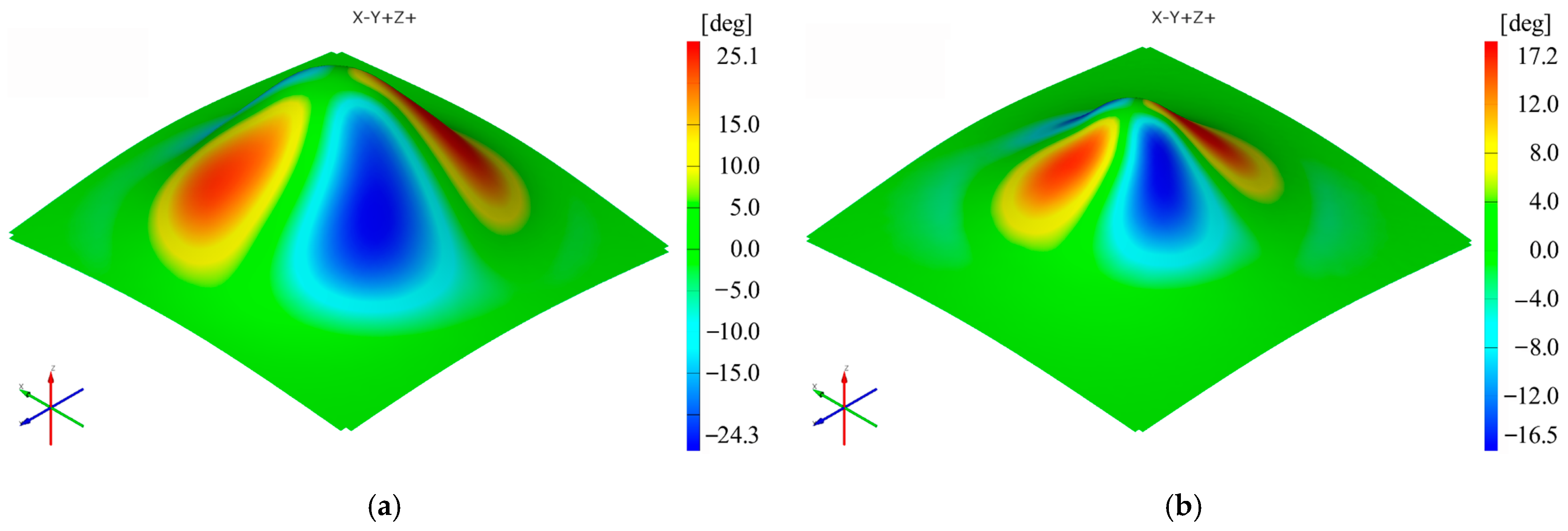
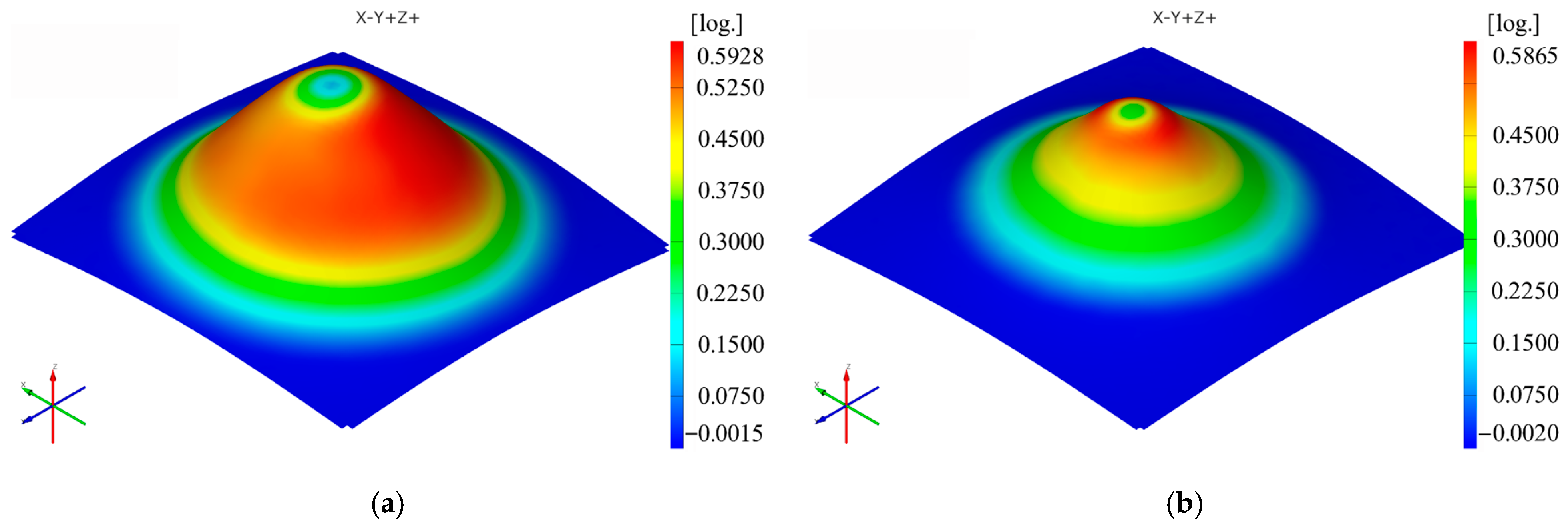

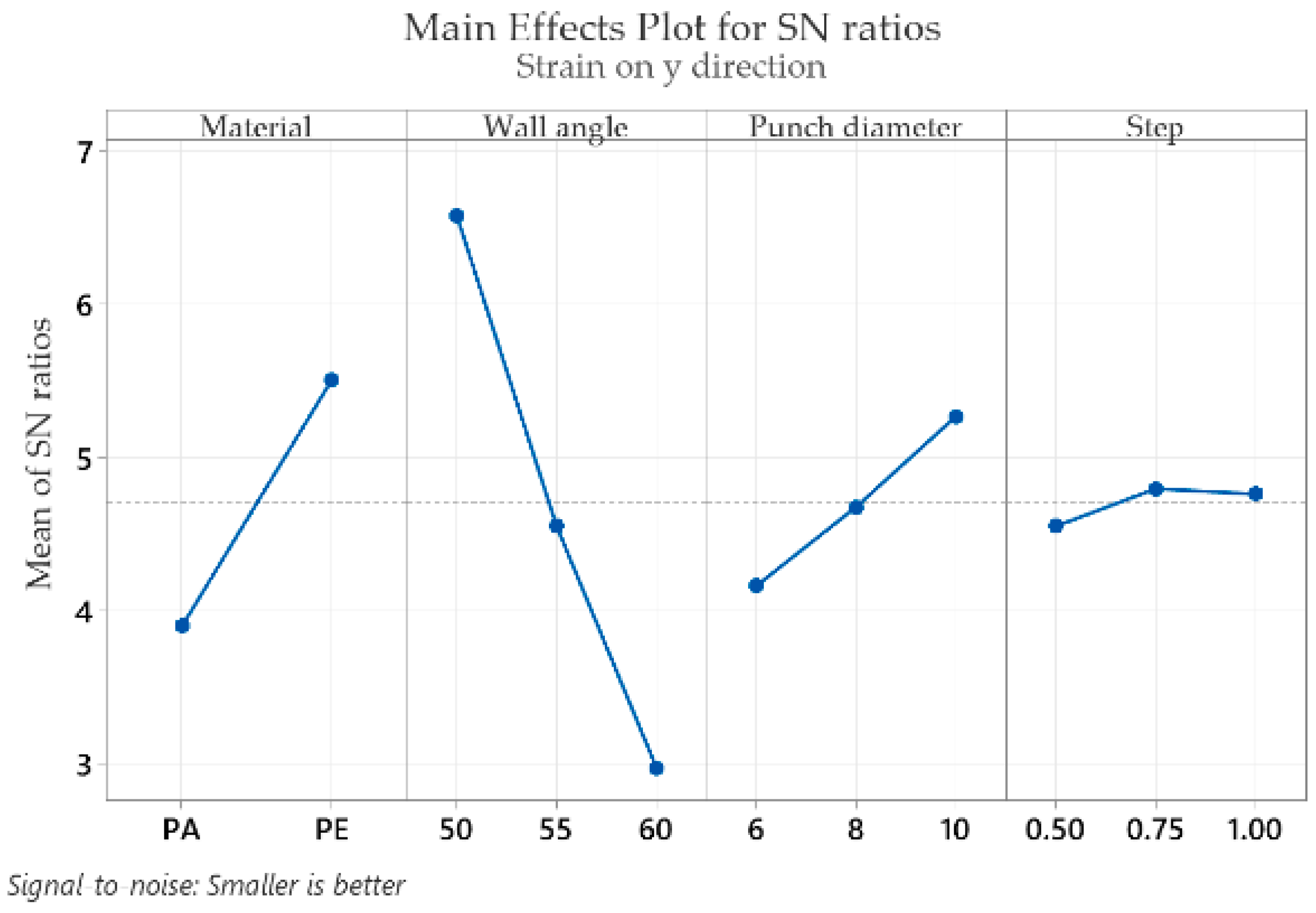
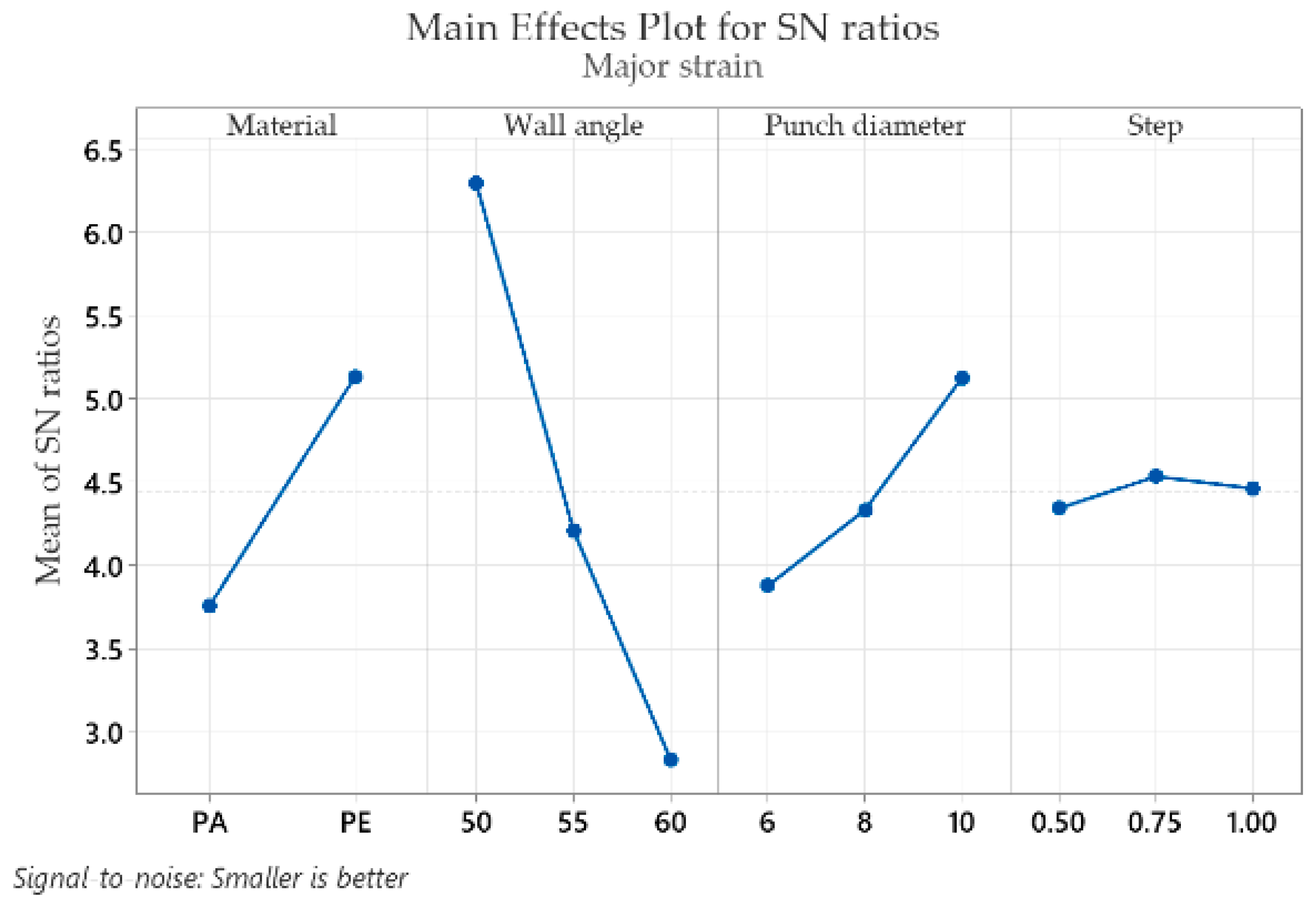
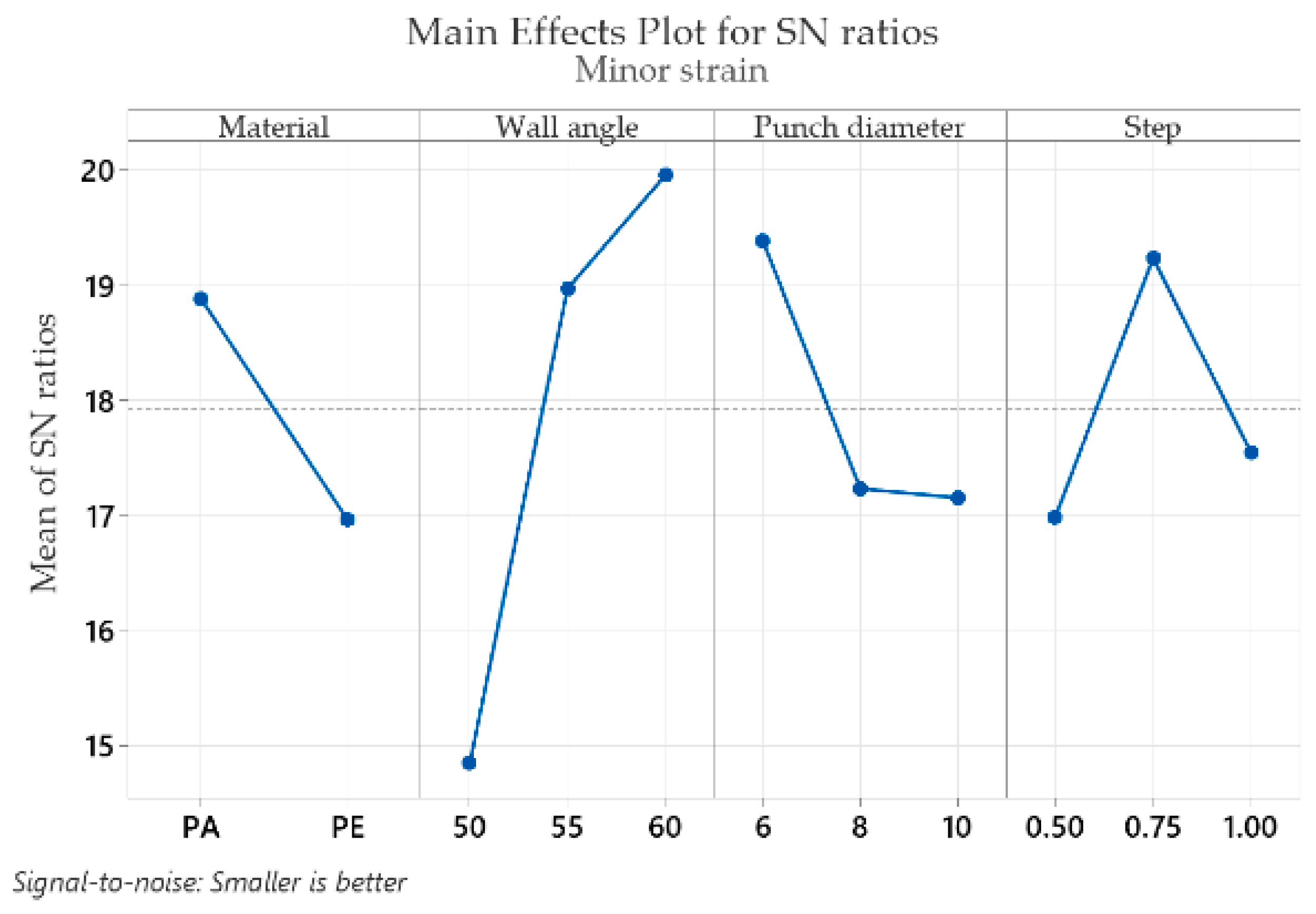


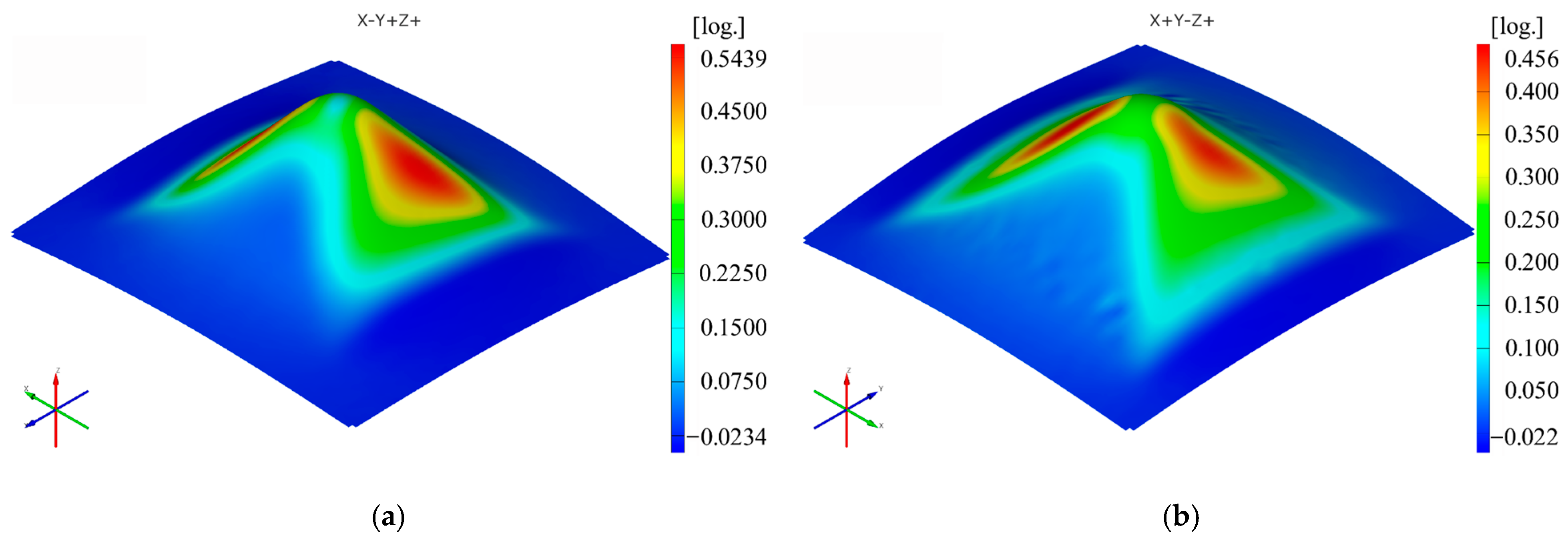
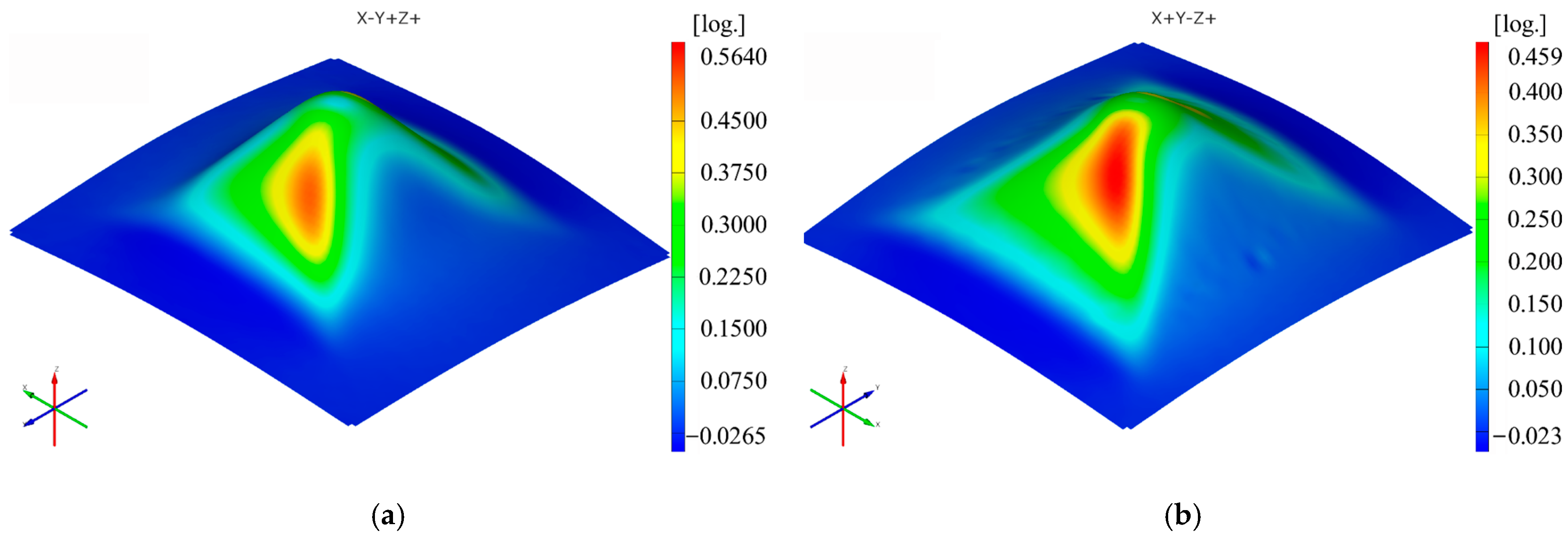


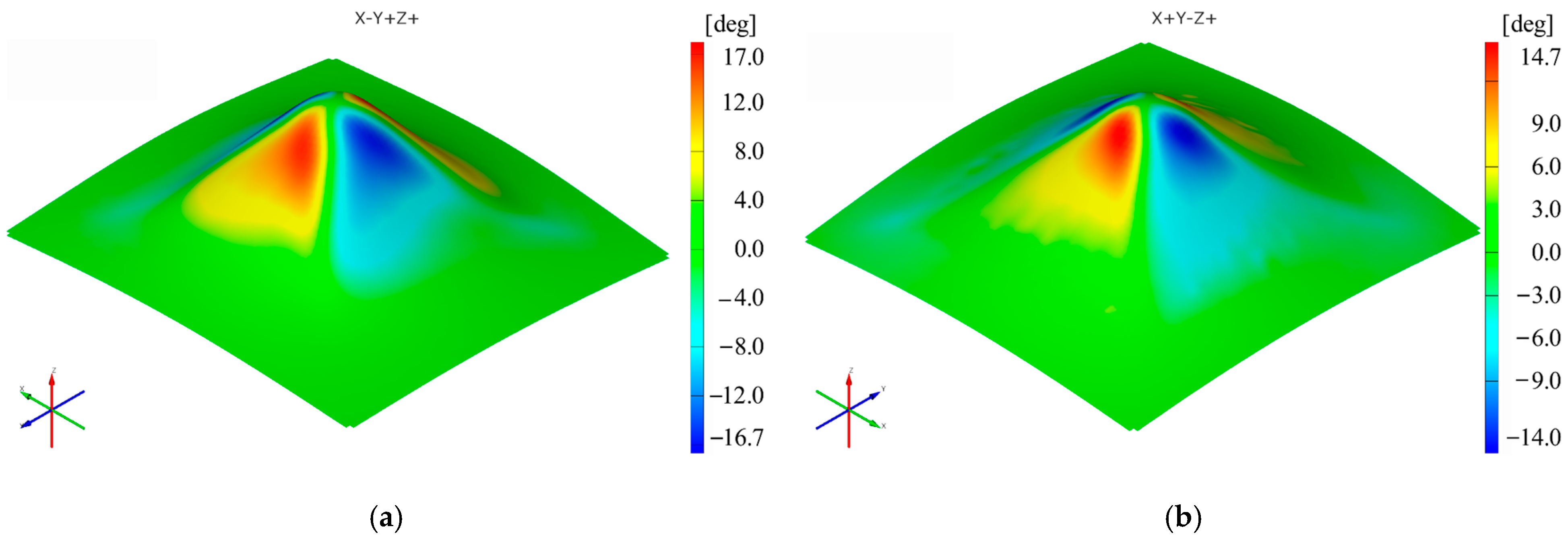

| Input Factors | Output Factors | ||||
|---|---|---|---|---|---|
| Code | Type | Symbol | Unit | Variation Domain | y1, y2, y3, y4, y5, y6 |
| x1 | Polymeric material | MAT | - | PA, HDPE | εx, εy, ε1, ε2, tr [mm/mm] and γxy [°] |
| x2 | Step down | s | (mm) | 0.5, 0.75,1 | εx, εy, ε1, ε2, tr [mm/mm] and γxy [°] |
| x3 | Punch diameter | Dp | (mm) | 6, 8, 10 | εx, εy, ε1, ε2, tr [mm/mm] and γxy [°] |
| x4 | Wall angle | α | (°) | 50, 55, 60 | εx, εy, ε1, ε2, tr [mm/mm] and γxy [°] |
| x5 | Initial thickness | g | (mm) | 0.5, 2, 5 | εx, εy, ε1, ε2, tr [mm/mm] and γxy [°] |
| x6 | Feed rate | vs | (mm/min) | 100, 1000, 2000 | εx, εy, ε1, ε2, tr [mm/mm] and γxy [°] |
| x7 | Punch angular speed | ω | (rot/min) | 50, 120, 180 | εx, εy, ε1, ε2, tr [mm/mm] and γxy [°] |
| Case | Mat. Code | α Code | Dp Code | s Code | Mat. | α (°) | Dp (mm) | s (mm) |
|---|---|---|---|---|---|---|---|---|
| S1 | −1 | −1 | −1 | −1 | PA | 50 | 6 | 0.50 |
| S2 | −1 | −1 | 0 | 0 | PA | 50 | 8 | 0.75 |
| S3 | −1 | −1 | 1 | 1 | PA | 50 | 10 | 1.00 |
| S4 | −1 | 0 | −1 | 0 | PA | 55 | 6 | 0.75 |
| S5 | −1 | 0 | 0 | 1 | PA | 55 | 8 | 1.00 |
| S6 | −1 | 0 | 1 | −1 | PA | 55 | 10 | 0.50 |
| S7 | −1 | 1 | −1 | 1 | PA | 60 | 6 | 1.00 |
| S8 | −1 | 1 | 0 | −1 | PA | 60 | 8 | 0.50 |
| S9 | −1 | 1 | 1 | 0 | PA | 60 | 10 | 0.75 |
| S10 | 1 | −1 | −1 | −1 | HDPE | 50 | 6 | 0.50 |
| S11 | 1 | −1 | 0 | 0 | HDPE | 50 | 8 | 0.75 |
| S12 | 1 | −1 | 1 | 1 | HDPE | 50 | 10 | 1.00 |
| S13 | 1 | 0 | −1 | 0 | HDPE | 55 | 6 | 0.75 |
| S14 | 1 | 0 | 0 | 1 | HDPE | 55 | 8 | 1.00 |
| S15 | 1 | 0 | 1 | −1 | HDPE | 55 | 10 | 0.50 |
| S16 | 1 | 1 | −1 | 1 | HDPE | 60 | 6 | 1.00 |
| S17 | 1 | 1 | 0 | −1 | HDPE | 60 | 8 | 0.50 |
| S18 | 1 | 1 | 1 | 0 | HDPE | 60 | 10 | 0.75 |
| Code | Mat. | α (°) | Dp (mm) | s (mm) | tr,1 (mm/mm) | tr,2 (mm/mm) | tr Mean (mm/mm) | Standard Deviation | S/N Ratio | Coefficient of Variation |
|---|---|---|---|---|---|---|---|---|---|---|
| S1 | PA | 50 | 6 | 0.5000 | 0.6372 | 0.6287 | 0.6330 | 0.0060 | 3.9724 | 0.0095 |
| S2 | PA | 50 | 8 | 0.7500 | 0.5928 | 0.5734 | 0.5831 | 0.0137 | 4.6839 | 0.0235 |
| S3 | PA | 50 | 10 | 1.0000 | 0.6074 | 0.6454 | 0.6264 | 0.0269 | 4.0590 | 0.0429 |
| S4 | PA | 55 | 6 | 0.7500 | 0.7380 | 0.7290 | 0.7335 | 0.0064 | 2.6918 | 0.0087 |
| S5 | PA | 55 | 8 | 1.0000 | 0.7044 | 0.6954 | 0.6999 | 0.0064 | 3.0991 | 0.0091 |
| S6 | PA | 55 | 10 | 0.5000 | 0.7473 | 0.7612 | 0.7543 | 0.0098 | 2.4493 | 0.0130 |
| S7 | PA | 60 | 6 | 1.0000 | 0.8960 | 0.8632 | 0.8796 | 0.0232 | 1.1128 | 0.0264 |
| S8 | PA | 60 | 8 | 0.5000 | 0.8860 | 0.9310 | 0.9085 | 0.0318 | 0.8308 | 0.0350 |
| S9 | PA | 60 | 10 | 0.7500 | 0.8480 | 0.8270 | 0.8375 | 0.0148 | 1.5396 | 0.0177 |
| S10 | HDPE | 50 | 6 | 0.5000 | 0.7047 | 0.6445 | 0.6746 | 0.0426 | 3.4104 | 0.0631 |
| S11 | HDPE | 50 | 8 | 0.7500 | 0.5865 | 0.5788 | 0.5827 | 0.0054 | 4.6917 | 0.0093 |
| S12 | HDPE | 50 | 10 | 1.0000 | 0.6375 | 0.6203 | 0.6289 | 0.0122 | 4.0276 | 0.0193 |
| S13 | HDPE | 55 | 6 | 0.7500 | 0.6820 | 0.7224 | 0.7022 | 0.0286 | 3.0672 | 0.0407 |
| S14 | HDPE | 55 | 8 | 1.0000 | 0.7740 | 0.7920 | 0.7830 | 0.0127 | 2.1242 | 0.0163 |
| S15 | HDPE | 55 | 10 | 0.5000 | 0.6107 | 0.6357 | 0.6232 | 0.0177 | 4.1057 | 0.0284 |
| S16 | HDPE | 60 | 6 | 1.0000 | 0.7479 | 0.7660 | 0.7570 | 0.0128 | 2.4180 | 0.0169 |
| S17 | HDPE | 60 | 8 | 0.5000 | 0.8320 | 0.8610 | 0.8465 | 0.0205 | 1.4462 | 0.0242 |
| S18 | HDPE | 60 | 10 | 0.7500 | 0.6614 | 0.7480 | 0.7047 | 0.0612 | 3.0235 | 0.0869 |
| Level | Material | Wall Angle | Punch Diameter | Step Down |
|---|---|---|---|---|
| 1 | 3.915 | 6.587 * | 4.180 | 4.575 |
| 2 | 5.492 * | 4.512 | 4.668 | 4.803 * |
| 3 | 3.011 | 5.263 * | 4.733 | |
| Delta | 1.577 | 3.576 | 1.083 | 0.227 |
| Rank | 2 | 1 | 3 | 4 |
| Level | Material | Wall Angle | Punch Diameter | Step Down |
|---|---|---|---|---|
| 1 | 3.900 | 6.582 * | 4.163 | 4.553 |
| 2 | 5.508 * | 4.553 | 4.679 | 4.797 * |
| 3 | 2.976 | 5.270 * | 4.762 | |
| Delta | 1.608 | 3.606 | 1.107 | 0.245 |
| Rank | 2 | 1 | 3 | 4 |
| Level | Material | Wall Angle | Punch Diameter | Step Down |
|---|---|---|---|---|
| 1 | 3.759 | 6.293 * | 3.877 | 4.343 |
| 2 | 5.132 * | 4.211 | 4.332 | 4.533 * |
| 3 | 2.833 | 5.127 * | 4.461 | |
| Delta | 1.373 | 3.460 | 1.249 | 0.190 |
| Rank | 2 | 1 | 3 | 4 |
| Level | Material | Wall Angle | Punch Diameter | Step Down |
|---|---|---|---|---|
| 1 | 18.88 * | 14.85 | 19.38 * | 16.98 |
| 2 | 16.96 | 18.96 | 17.23 | 19.23 * |
| 3 | 19.95 * | 17.15 | 17.55 | |
| Delta | 1.92 | 5.10 | 2.23 | 2.25 |
| Rank | 4 | 1 | 3 | 2 |
| Level | Material | Wall Angle | Punch Diameter | Step Down |
|---|---|---|---|---|
| 1 | −29.73 | −26.22 * | −29.21 | −28.55 |
| 2 | −27.39 * | −28.99 | −28.59 | −28.63 |
| 3 | −30.47 | −27.89 * | −28.50 | |
| Delta | 2.34 | 4.25 | 1.32 | 0.13 |
| Rank | 2 | 1 | 3 | 4 |
| Level | Material | Wall Angle | Punch Diameter | Step Down |
|---|---|---|---|---|
| 1 | 2.715 | 4.141 * | 2.779 | 2.702 |
| 2 | 3.146 * | 2.923 | 2.813 | 3.283 * |
| 3 | 1.729 | 3.201 * | 2.807 | |
| Delta | 0.431 | 2.412 | 0.422 | 0.580 |
| Rank | 3 | 1 | 4 | 2 |
| Source | Degree of Freedom | Adjusted Value of the Sum of Squares | F Value | p-Value | Contribution (%) |
|---|---|---|---|---|---|
| MAT | 1 | 11.1881 | 80.88 | 0 | 20.47 |
| α | 2 | 38.6838 | 139.82 | 0 | 70.75 |
| Dp | 2 | 3.5296 | 12.76 | 0.007 | 6.46 |
| s | 2 | 0.1625 | 0.59 | 0.585 | 0.3 |
| MAT×Dp | 2 | 0.1426 | 0.52 | 0.622 | 0.26 |
| MAT×s | 2 | 0.1315 | 0.48 | 0.643 | 0.24 |
| Residual error | 6 | 0.83 | 1.52 | ||
| Total | 17 | 54.668 |
| Source | Degree of Freedom | Adjusted Value of the Sum of Squares | F Value | p-Value | Contribution (%) |
|---|---|---|---|---|---|
| MAT | 1 | 11.6346 | 60.38 | 0 | 20.69 |
| α | 2 | 39.2186 | 101.76 | 0 | 69.75 |
| Dp | 2 | 3.6843 | 9.56 | 0.014 | 6.55 |
| s | 2 | 0.2098 | 0.54 | 0.606 | 0.37 |
| MAT×Dp | 2 | 0.1799 | 0.47 | 0.648 | 0.32 |
| MAT×s | 2 | 0.1442 | 0.37 | 0.703 | 0.26 |
| Residual error | 6 | 1.1562 | 2.06 | ||
| Total | 17 | 56.2275 |
| Source | Degree of Freedom | Adjusted Value of the Sum of Squares | F Value | p-Value | Contribution (%) |
|---|---|---|---|---|---|
| MAT | 1 | 8.4813 | 78.96 | 0 | 16.51 |
| α | 2 | 36.4153 | 169.51 | 0 | 70.88 |
| Dp | 2 | 4.7971 | 22.33 | 0.002 | 9.34 |
| s | 2 | 0.111 | 0.52 | 0.621 | 0.22 |
| MAT×Dp | 2 | 0.5708 | 2.66 | 0.149 | 1.11 |
| MAT×s | 2 | 0.3557 | 1.66 | 0.268 | 0.69 |
| Residual error | 6 | 0.6445 | 1.25 | ||
| Total | 17 | 51.3755 |
| Source | Degree of Freedom | Adjusted Value of the Sum of Squares | F Value | p-Value | Contribution (%) |
|---|---|---|---|---|---|
| MAT | 1 | 16.532 | 18.14 | 0.005 | 11.08 |
| α | 2 | 87.897 | 48.23 | 0 | 58.93 |
| Dp | 2 | 19.171 | 10.52 | 0.011 | 12.85 |
| s | 2 | 16.372 | 8.98 | 0.016 | 10.98 |
| MAT×Dp | 2 | 1.407 | 0.77 | 0.503 | 0.94 |
| MAT×s | 2 | 2.309 | 1.27 | 0.348 | 1.55 |
| Residual error | 6 | 5.468 | 3.67 | ||
| Total | 17 | 149.156 |
| Source | Degree of Freedom | Adjusted Value of the Sum of Squares | F Value | p-Value | Contribution (%) |
|---|---|---|---|---|---|
| MAT | 1 | 24.6132 | 1249.1 | 0 | 28.39 |
| α | 2 | 55.969 | 1420.2 | 0 | 64.55 |
| Dp | 2 | 5.2589 | 133.44 | 0 | 6.07 |
| s | 2 | 0.0504 | 1.28 | 0.345 | 0.06 |
| MAT×Dp | 2 | 0.536 | 13.6 | 0.056 | 0.62 |
| MAT×s | 2 | 0.1552 | 3.94 | 0.081 | 0.18 |
| Residual error | 6 | 0.1182 | 0.14 | ||
| Total | 17 | 86.7009 |
| Source | Degree of Freedom | Adjusted Value of the Sum of Squares | F Value | p-Value | Contribution (%) |
|---|---|---|---|---|---|
| MAT | 1 | 0.8345 | 2.49 | 0.166 | 3.41 |
| α | 2 | 17.4585 | 26.06 | 0.001 | 71.38 |
| Dp | 2 | 0.6598 | 0.98 | 0.427 | 2.7 |
| s | 2 | 1.1492 | 1.72 | 0.257 | 4.7 |
| MAT×Dp | 2 | 1.3406 | 2 | 0.216 | 5.48 |
| MAT×s | 2 | 1.0056 | 1.5 | 0.296 | 4.11 |
| Residual error | 6 | 2.0095 | 8.22 | ||
| Total | 17 | 24.4576 |
| Variable | Coefficient | SE Coefficient | T Value | p-Value |
|---|---|---|---|---|
| Constant term | −0.633 | 0.149 | −4.25 | 0.008 |
| Punch diameter (Dp) | −0.00233 | 0.00614 | −0.38 | 0.721 |
| Step down (s) | −0.0599 | 0.0491 | −1.22 | 0.277 |
| Wall angle (α) | 0.02610 | 0.00246 | 10.63 | 0.000 |
| Variable | Coefficient | SE Coefficient | T Value | p Value |
|---|---|---|---|---|
| Constant term | 0.032 | 0.328 | 0.10 | 0.925 |
| Punch diameter (Dp) | −0.0147 | 0.0135 | −1.09 | 0.326 |
| Step down (s) | 0.016 | 0.108 | 0.15 | 0.886 |
| Wall angle (α) | 0.01407 | 0.00541 | 2.60 | 0.048 |
| Wall Angle (α) | Punch Diameter (Dp) | Step Down (s) | |
|---|---|---|---|
| Decrease in strains in x and y directions εx and εy | As α decreases | As Dp increases | At the mean value of s |
| Decrease in major strain ε1 | As α decreases | As Dp increases | At the mean value of s |
| Decrease in minor strain ε2 | As α increases | As Dp decreases | At the mean value of s |
| Decrease in shear angle γxy | As α increases | As Dp increases | As s increases |
| Decrease in thickness reduction tr | As α decreases | As Dp increases | At the mean value of s |
Disclaimer/Publisher’s Note: The statements, opinions and data contained in all publications are solely those of the individual author(s) and contributor(s) and not of MDPI and/or the editor(s). MDPI and/or the editor(s) disclaim responsibility for any injury to people or property resulting from any ideas, methods, instructions or products referred to in the content. |
© 2023 by the authors. Licensee MDPI, Basel, Switzerland. This article is an open access article distributed under the terms and conditions of the Creative Commons Attribution (CC BY) license (https://creativecommons.org/licenses/by/4.0/).
Share and Cite
Rosca, N.; Oleksik, M.; Rosca, L.; Avrigean, E.; Trzepieciński, T.; Najm, S.M.; Oleksik, V. Minimizing the Main Strains and Thickness Reduction in the Single Point Incremental Forming Process of Polyamide and High-Density Polyethylene Sheets. Materials 2023, 16, 1644. https://doi.org/10.3390/ma16041644
Rosca N, Oleksik M, Rosca L, Avrigean E, Trzepieciński T, Najm SM, Oleksik V. Minimizing the Main Strains and Thickness Reduction in the Single Point Incremental Forming Process of Polyamide and High-Density Polyethylene Sheets. Materials. 2023; 16(4):1644. https://doi.org/10.3390/ma16041644
Chicago/Turabian StyleRosca, Nicolae, Mihaela Oleksik, Liviu Rosca, Eugen Avrigean, Tomasz Trzepieciński, Sherwan Mohammed Najm, and Valentin Oleksik. 2023. "Minimizing the Main Strains and Thickness Reduction in the Single Point Incremental Forming Process of Polyamide and High-Density Polyethylene Sheets" Materials 16, no. 4: 1644. https://doi.org/10.3390/ma16041644






